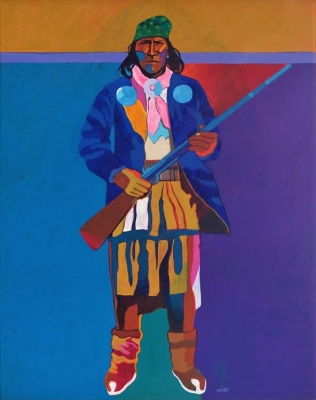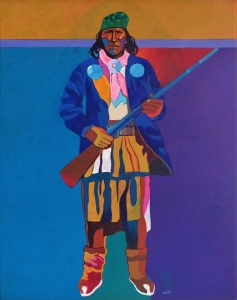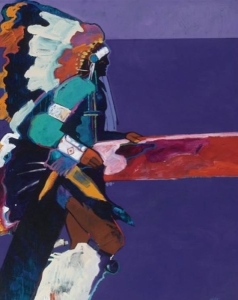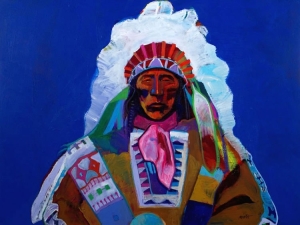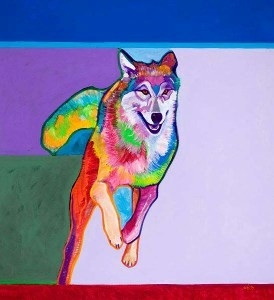John Nieto (1936-2018) called himself an American artist who paints Indians, not an Indian artist. An acclaimed leader of his field, but taking a separate path to represent Native Americans in striking symbolic portraits, Nieto's work has been exhibited worldwide and has had paintings accepted for the Presidential library.
He did not attempt to be authentic, but to show a core Native spirit. His Indians seem to belong to a universal tribe that suggest a common, Far Eastern origin,
More
John Nieto (1936-2018) called himself an American artist who paints Indians, not an Indian artist. An acclaimed leader of his field, but taking a separate path to represent Native Americans in striking symbolic portraits, Nieto's work has been exhibited worldwide and has had paintings accepted for the Presidential library.
He did not attempt to be authentic, but to show a core Native spirit. His Indians seem to belong to a universal tribe that suggest a common, Far Eastern origin, and connection with a contemporary group.
Early this century, Indian artists were cultivated in a white man's school and encouraged to portray ancestral and reservation experiences. Art from that period was inauthentic and oblivious to world trends. Since mid-century, Indian-born artists began to tell a bitter truth of Indian pain from alcoholism and other social problems.
John Nieto belonged to neither camp. His Indians are not idealized or troubled. They are potters, warriors, silversmiths or shamans in traditional garb, as well as indigenous wildlife, painted in brilliant, oddly paired colors and radiating a quiet dignity.
"There is no formula for my faces. I paint the dance of identity around the pan-Indian bone structure of all Native Americans. I am painting a person, but I am painting much more than that," said Nieto. He said that his art "is the result of an emotional involvement with my subject matter rather than a cerebral one."
He used broad strokes and thick layers of brilliant colors with a halo of contrasting color traced around each figure. His electric hues are unmistakable. Nieto's work reflects his upbringing from Hispanic and Indian-born parents. His distinct style comes not only from his native New Mexico, but also from a global awareness and travels to Europe.
His unfettered use of brilliant colors has been likened to the Fauves of the 1920s' French movement. Nieto spent time in Paris and also seemed to be influenced by European expressionists who released the subconscious onto canvases. He also used painting techniques and a spiritual awareness from the Far East.
His approach was ritualistic. "I'm in a trance when I paint. It's like being a drummer -- you don't look at the drums, you just know intuitively where they are."
An artist of established international reputation, Nieto's work has been exhibited in Europe, Japan, Latin America, and Africa, in addition to his annual shows in Santa Fe, New York and Palm Springs. In 1981 his work was exhibited at the Salon D`Automne/Grand Palais in Paris, France. His work, the subject of two books and numerous articles, is also represented in the permanent collection of the National Museum of Wildlife Art.
In 1994, Nieto received New Mexico's Governor's Award for achievement in the Arts. He has served on the Advisory Board of The Wheelwright Museum in Santa Fe, the Advisory Board of the Native American Preparatory School, and was a Regent at his alma mater, Southern Methodist University in Dallas, where he received his Bachelor of Arts Degree.
Permanent Museum Collections:
Booth Museum, Cartersville, GA
National Museum of Wildlife Art, Jackson Hole, WY
The Blanton Museum of Art at The University of Texas at Austin, Austin TX
New Mexico Museum of Fine Arts, Santa Fe, NM
Marine Corp Museum, Washington, D.C.
The Heard Museum, Phoenix, AZ
,and others.
John Nieto was also a part of the Art in Embassies Program since 1982. The embassies in which his art is and has shown are as follows:
Rangoon, Burma, 2006 – Present
Cairo, Egypt, 2002 – 2005
Jakarta, Indonesia, 2000 – 2005
Bangkok, Thailand, 1999
Manama, Bahrain, 1998
Caracas, Venezuela, 1997
Lima, Peru, 1996
Tokyo, Japan, 1991
La Paz, Bolivia, 1989
Luxembourg Embassy, Washington, D.C. 1983
US Embassy & US International Communications Agency, Barbados 1982
Sources:
www.askart.com
www.artlifearizona.com
exhibition and collection information courtesy of the artist's son, Anaya Nieto
Less
